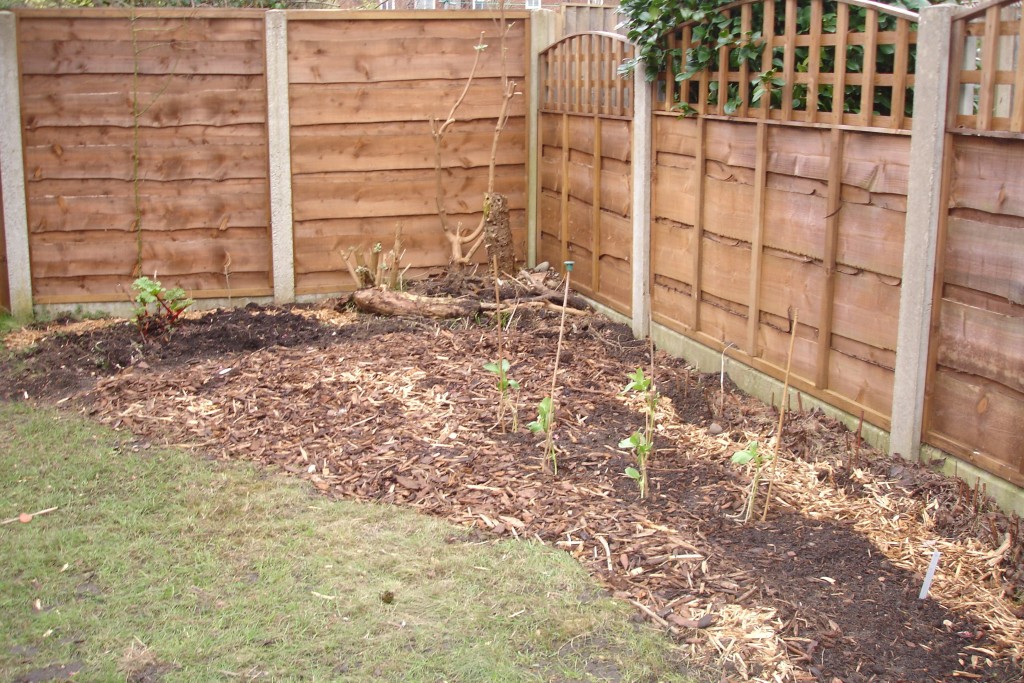Inspired by some of the beautiful plots in my local allotments, we started thinking about putting some beds into our back garden for a kind of ‘kitchen-cottage garden’. The general plan is to try growing a few vegetables (tomatoes and climbing beans) among flowers and herbs. During the planning process, we found ourselves drawn to people using permaculture principles, so the experiment has become an opportunity to learn more about this way of partnering with nature.
This is what we were starting from…

Gardening guru Huw Richards suggests having a ‘mission statement’ for the year, and our intentions are to use this space to develop a more embodied connection with nature, to challenge ourselves to move away from comfort and convenience, and for my son and I to learn about permaculture together, as we figure it out.
We decided to take out pieces of lawn, but not to install raised beds just yet. That way, if this isn’t for us in the long-term, we can just let the lawn grow back in again.
First, we dug out the grass. I’d heard about ‘no-dig’ beds (also known as sheet mulch or ‘lasagna’ gardening), where you just lay cardboard and compost over existing lawn – but I had read that it may not be very productive in the first season, and I wasn’t sure if I could source enough cardboard and compost all in one go. After removing the sod, we dug a couple of trenches and filled these with compost, filled them in, and then added another layer of compost over the top of the bed.
In one of the beds we put woodchip over the whole of the bed.

We’re moving the woodchip out of the way onto the paths as we begin planting – we were a little impatient with our indoor seed-starting and these broad beans seemed happier outdoors:

In the other bed, we laid woodchip just for where the paths will be, as we’ll be direct-sowing here quite soon. As you can see from the photos, we’ve left ourselves a few places to tidy up around the edges, but it felt good to have the main bulk of the work done!

From the leftover sod, I created my version of a ‘Hugelkultur mound’ in two different spots, by layering the sod upside down, then covering with cardboard and some coco coir mixed with topsoil. These are a work-in-progress experiment, to see if I can get a ‘meadow patch’ growing on them for pollinators. I also accidentally ended up with what is known as a ‘loam stack’ (or turf stack) – which is covered with a tarp for now to help kill off the grass, while I try to learn more about how to turn this material into something useable.

None of this comes naturally to me, as I’m really not a gardener. We spent a good while planning, sketching and watching vidoes for inspiration and ideas about what to grow. The most helpful plan we drew was the large-scale drawing we’ve pinned to our dining-room wall. We used post-it notes and blu-tac for move-able plant labels – as they moved around alot as we were considering things like how much sun they need, what height they would grow to, and what we wanted to have next to each other.
This is an overview of what we’ve chosen to grow and why…
Vegetables: tomatoes, broad beans and runner beans – because they are things that everyone in the family will eat, and we’re building on some (very minimal) experience we’ve had growing these before.
Perennial edible greens: lovage, sorrel and good king henry – because they don’t necessarily need full sun, and they will fit around other things we want to grow.
Annual flowers: cornflowers, poppies, sunflowers, sweet peas, nasturtiums, calendula and borage – partly for prettiness and fragrance, but also to attract pollinators and to help deter pests. Some of these can also be used for ‘chop and drop’ mulch as a way to improve soil, and I’m hoping some will self-seed so we get them back in future years.
Perennial herbs: chamomile, oregano, savory, chives, mint and lemon balm – for culinary purposes and to help deter pests.
Meadow flowers: clover, toadflax, forget-me-nots, ox-eye daisies, yarrow and knapweed – to convert my leftover piles of grass sod into mini meadows for pollinators.
We ended up with a longer list of plants than I originally intended, but I figure if we try lots of different things and only a few of them work, then I’ll be happy with that. And if a few more of them grow, we’ll have a good bit of biodiversity for wildlife.
The planning stage was lots of fun, and I gained alot of motivation and encouragement from the following resources in particular:
‘The Vegetable Grower’s Handbook’ by Huw Richards (from my local library), especially the sections on planning.
‘Gaia’s Garden: A Guide To Home-Scale Permaculture’ by Toby Hemenway
‘Homesteading Family‘ YouTube channel, especially the Cottage Garden playlist.
‘Old Fashioned On Purpose’ podcast – the episode ‘How To Switch Out You Store-bought Veggies For Homegrown Ones‘ was full of reassurance that you really don’t have to start out doing any of this ‘perfectly’.